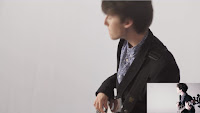A time lapse showing the whole shoot day. It shows the transformation of the studio during the day, including putting up the cyclorama, lights, and all the actors and camera.
 |
| Me (2 from left) getting my make-up done. |
I really enjoyed the shoot day and I felt really excited to be immersed in such a new environment. I particularly enjoyed working with the industry standard equipment for the first time, as well as working with industry professionals. This gave me a better understanding of how media works on a wider scale, as I saw how all the different roles tie together, from director to runner. It also allowed me to realise how every role in a shoot is important. For example, the director is important as they give the creative input into the shoot, and the seemingly small role of the cable basher is important, as it allows the camera operator to take the best shots possible without the cable getting in the way.
 |
| Me cable bashing. |
- Really got my day off to a great start.
- The thing I found most interesting when taking charge of the clapperboard, which I had never considered before, is what Robin told me about marking the shot correctly. He said that the clapperboard should always enter the shot open, rather than to enter the shot and then open. This really intrigued me as I had never thought that there would be a correct way to mark a shot using a clapperboard.
- Another thing I learnt when using the clapperboard was when I asked Amy about industry standard clapperboards, and I found out that in most simple shoots, simple clapperboards like the one we had are used, but in feature film production, the use digital clapperboards that have a timer and are sometimes linked to the camera to make them start recording.
Cable Basher:
- I did this when Robin was shooting the handheld shots of Laith. I really enjoyed this role, as it meant I virtually got to shadow Robin as camera op, which is the sort of career I would like to have when I am older.
- However, I did find it very difficult to keep the cable at the correct length constantly.
 |
| Me acting with the flag. |
- My final role was as an actor, playing the part of "cool kid 7". This allowed me to gain insight into a role I do not usually take, and it made me think about what to say/what techniques to use when trying to get an actor to do something.
My favourite parts of the shoot day were:
- Watching Robin and Dom adjust the focus of the lens when setting up the shot. I found it interesting to see how a subtle difference in the lens can cause such a deep or shallow focus, and I could apply it to things I have watched/ read about outside of school.
- Getting my make-up done. It was really exciting to enter a new world (sort of).
- Watching everyone do their own jobs when I had a free moment to sit down. For example watching assistant camera operator (Tom) doing cable bashing with a very skilled technique which I was able to try myself (but was not very good). However, he was not there for the full shoot day, but instead just the practice sessions.







